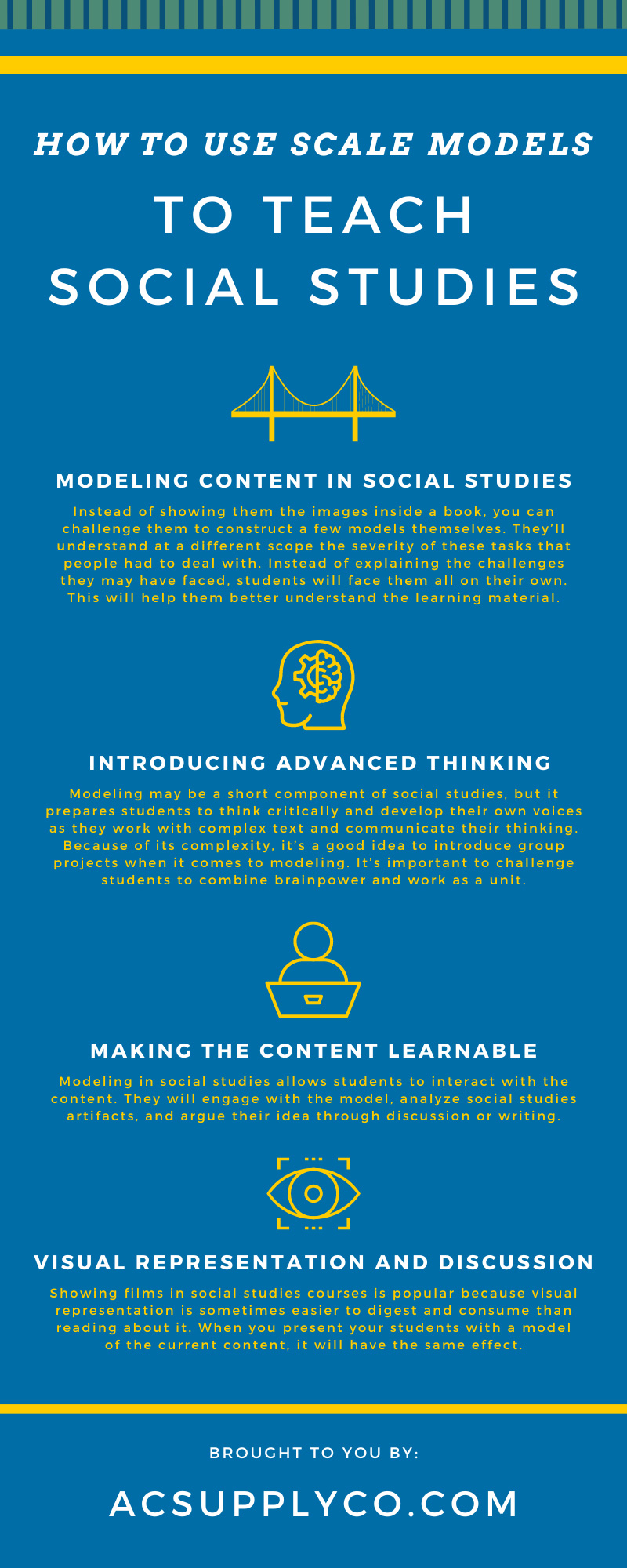Educators are always looking for new ways to teach some of the more complicated and difficult subjects, like social studies. Learning should be fun. When lessons become stale and stagnant, you run the risk of losing the attention of your pupils.
Social studies is a multifaceted course that covers more than history, and taking a new approach to teaching the subject is beneficial for both parties. Here’s how to use scale models to teach social studies.
Understanding Social Studies
A big component of social studies is history, but that’s not all it is. Students make the mistake of confusing the two courses with one another. This course covers topics beyond history. While history will cover past events, particularly in human affairs, social studies get far more intricate.
Social studies is the integrated study of multiple fields of social science and humanities, including history, culture, geography, and political science. Social studies trains students for informed, responsible participation in a diverse democratic society. Understanding the purpose will help teachers incorporate scale models into the curriculum.
Every lesson involving models will come back to the overall goal of the course. Use these smaller sections of the curriculum to break down the pieces of a bigger whole.
The National Council for Social Studies claims that there are 10 themes that present the standard of human experience. These include
- Culture
- Time, continuity, and change
- People, places, and environment
- Individual development and identity
- Individuals, groups, and institutions
- Power, authority, and governance
- Production, distribution, and consumption
- Science, technology, and society
- Global connections
- Civic ideals and practices
Modeling Content in Social Studies
History isn’t everyone’s favorite subject. Some are fascinated to see how the world once was and what it has transformed to be. They also find it interesting to see how some events from the past are repeating themselves in the present.
But the majority of educators teach the subject through a textbook and an occasional movie. These aren’t always the best practices for students. Modeling offers another option. Imagine teaching students about The Great Wall of China and how it came to be.
Instead of showing them the images inside a book, you can challenge them to construct a few models themselves. They’ll understand at a different scope the severity of these tasks that people had to deal with. Instead of explaining the challenges they may have faced, students will face them all on their own. This will help them better understand the learning material.
Introducing Advanced Thinking
As previously stated, social studies is about preparing students to become more advanced thinkers in society. The subject provides them with the tools they need to make informed and valued decisions and draw conclusions that are more than one-dimensional.
Modeling may be a short component of social studies, but it prepares students to think critically and develop their own voices as they work with complex text and communicate their thinking. Because of its complexity, it’s a good idea to introduce group projects when it comes to modeling. It’s important to challenge students to combine brainpower and work as a unit.
Most of the events taught in social studies required group work. After all, constructing and developing an entire society is not a one-person task. Therefore, the lessons should reflect the same structure. As they say, “Rome wasn’t built in a day,” and it didn’t fall on the back of one person.
Making the Content Learnable
Modeling in social studies allows students to interact with the content. They will engage with the model, analyze social studies artifacts, and argue their idea through discussion or writing.
Take 10 minutes during the engagement section of your class to access students’ knowledge, make connections between the knowledge and the lesson, and then pose a central question. The experience portion happens in two sections: modeling and practicing.
Modeling should take about five minutes, and you should provide instructions that students will use for the lesson. Depending on the task, practicing will run between 20 minutes to an hour. Students will practice their chosen strategy modeled with the help of sources supplied in the lesson.
Finally, the argument portion should surround a general discussion that answers the original question the teacher posed and have students describe their chosen model in detail.
Technological Advancements in Social Studies
Since science, technology, and society are among the themes covered in the curriculum, we need to think about how that plays into modeling. There are several technological advancements in society that are worth mentioning and exploring.
It’s easier to explain these advancements when students have a physical representation of the content. Think about how civilizations discovered new ways to travel and transport items, from railroads to cars, planes, and bridges. There’s a lot of ground to cover.
Students will begin to understand the relationship between science, technology, and society, the advancements made throughout the years, and the impacts they have had when you have them build models. For example, challenge your students and see what they can create using one of our Estes model rocket kits. They’ll get some hands-on experience and learn more about what goes into making rockets.
Visual Representation and Discussion
Showing films in social studies courses is popular because visual representation is sometimes easier to digest and consume than reading about it. When you present your students with a model of the current content, it will have the same effect.
Teaching about a complex thing, such as a bridge or rocket ship, can invoke discussion like, “This makes me think.” While this is essential, students may not know where to start when it comes to learning more about it. However, a model breaks down the inquiries and makes the information easier to understand.
Think of some of the more difficult lessons and what the benefits of a model can do for your students. This will help you find a model specifically geared toward this area of your curriculum.
At AC Supply, we want to help educators find new and exciting ways to teach their students. Using scale models in social studies is one subject we assist with. For more information, visit our website.



